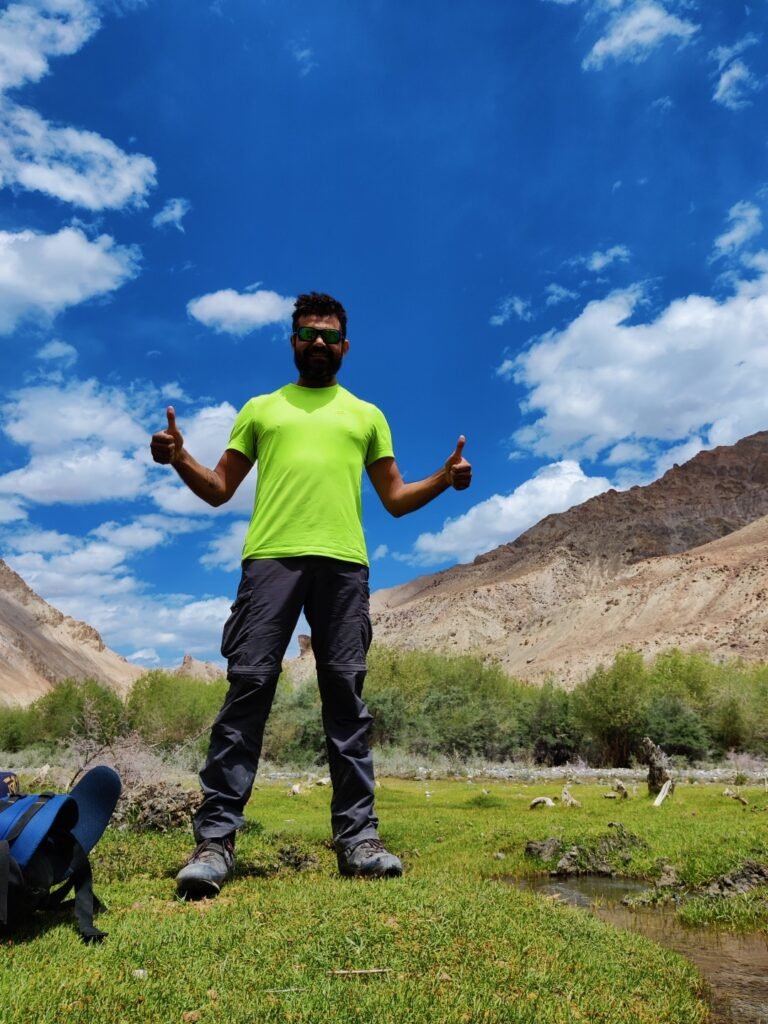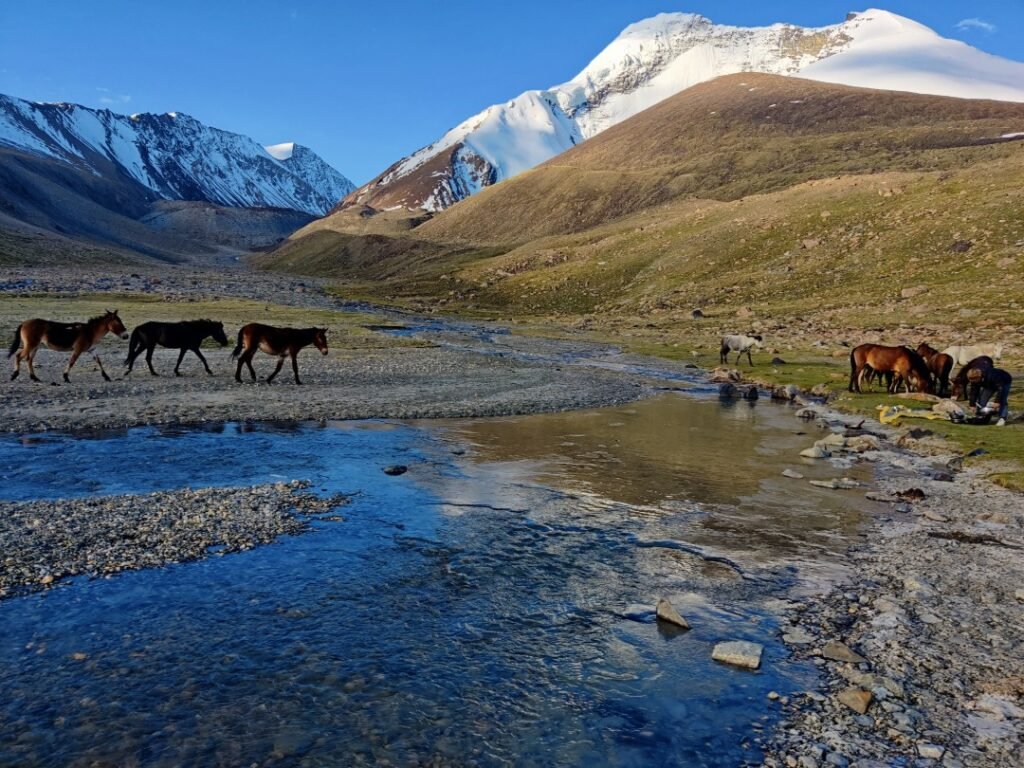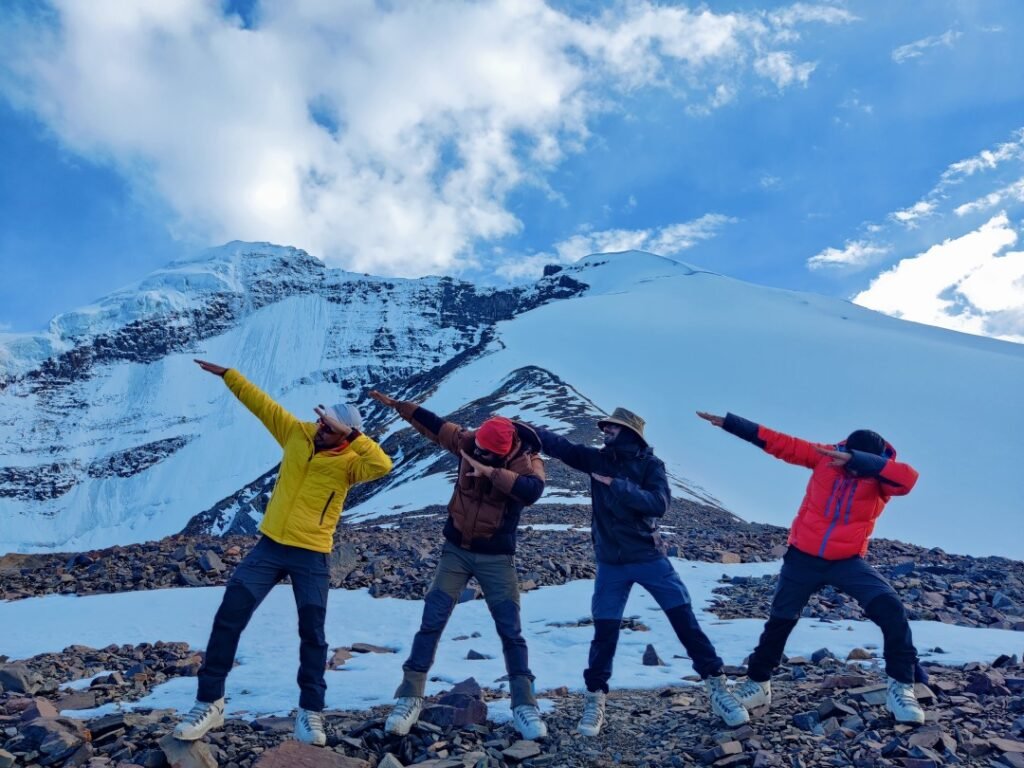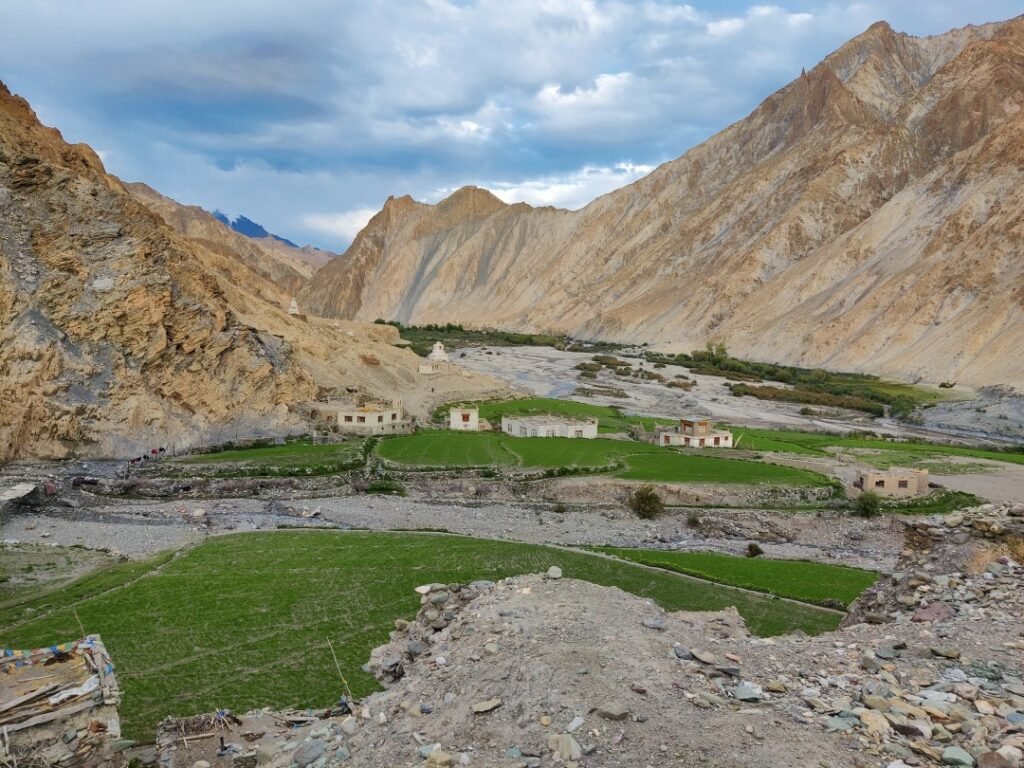Kang Yatse II Trek
Explore, ascend, and conquer— a 6,250M adventure for experienced trekkers in the heart of Ladakh
Talk to an Expert
Trek Difficulty
Challenging
Trek Duration
12 Days (Leh to Leh)
Highest Altitude
6,250 meters
Suitable For
Experienced trekkers
Accommodation
Twin/Triple sharing*
Total Trek Distance
75–80 km approx
Basecamp
Leh
Accomm. Type
Guesthouses/hotels/Tents
Pickup Point
Leh Airport
Accommodation Level
Economical
Kang Yatse II Trek
A Challenging Himalayan Ascent for Experienced Trekkers
The Kang Yatse II Trek is a challenging high-altitude adventure in Ladakh, perfect for experienced trekkers.
This 12-day journey follows the scenic Markha Valley, leading to 6,250m summit, requiring crampons, ropes, and technical skills for the final ascent.
Stunning Himalayan views and cultural experiences await.
Trek Fee
INR 55,000 per person (Leh to Leh, all-inclusive)
Optional Add-ons
- Backpack offloading - Rs. 4500
- Single tent accommodation - Rs. 2500
- Travel and Emergency Insurance
Available Dates to Register
- 10 - 21 July
- 5 - 16 August 2025
Additional Information
Inclusions & Exclusions
Inclusions
- Comfortable guesthouse/hotel stays in Leh (Day 1, 2, and 11).
- Nutritious vegetarian+egg meals from lunch on Day 3 to lunch on Day 11.
- Essential technical climbing gear: ropes, helmet, ice axe, crampons, mountaineering boots (for summit day).
- High-quality camping equipment: twin-sharing tents, sub-zero sleeping bags, insulated mats.
- Terrain-specific gear: gaiters, crampons, microspikes.
- Certified expedition leader, experienced mountain guides, skilled support crew.
- Private transport from Leh to trek start point and back.
- Safety measures: well-stocked first aid kit, portable oxygen cylinder, stretcher, evacuation support.
- Kathmandu airport pickup and drop-off.
- All government and local taxes.
- Meals during the trek if opted for the meal plan.
Exclusions
- Meals in Leh (Day 1, 2, and 11 not included).
- Meals during road transfers.
- Personal expenses (snacks, drinks, tips, laundry, souvenirs).
- Travel insurance (highly recommended but not provided).
- Personal porter or mule (available at extra cost).
- Inner Line Permit and IMF registration fees (payable in Leh).
- Buffer day charges (if reserve day is used, extra costs apply).
- Anything not specifically mentioned in inclusions.
What Makes Kang Yatse II a Must-Do Trek?
A True High-Altitude Challenge
At 6,250 meters, Kang Yatse II offers an ideal semi-technical climb for experienced trekkers preparing for bigger Himalayan expeditions.
Scenic Markha Valley Trail
The trek takes you through picturesque Ladakhi villages, Buddhist monasteries, and diverse landscapes, from lush valleys to rugged high-altitude terrain.
Exciting Summit Push
The final ascent involves crampons, ropes, and ice axes, making it a thrilling introduction to mountaineering without extreme technical difficulty.
Panoramic Himalayan Views
From the summit, gaze at the Zanskar and Karakoram ranges, with an uninterrupted view of Ladakh’s vast landscapes.
A Well-Rounded Expedition Experience
Beyond trekking, this journey includes altitude adaptation, expedition-style camping, and technical training, making it a complete mountaineering adventure.

Kang Yatse II Trek – 12 Days Detailed Itinerary
Day 1: Arrival in Leh (3,500 M)
- Arrive in Leh, the capital of Ladakh, and settle into your accommodation.
- Rest and allow your body to acclimatize to the high altitude (3,500M).
- Explore Leh’s local markets, monasteries, and landmarks like Leh Palace and Shanti Stupa.
- Stay hydrated and avoid exertion to adapt smoothly to the altitude.
Day 2: Acclimatization and Exploration in Leh (3,500 M)
- Spend a full day acclimatizing before heading to higher altitudes.
- Visit historical sites like Thiksey Monastery, Shey Palace, and Hemis Monastery.
- Short walks around Leh help prepare your body for the trek.
- Briefing session about the trek, ensuring all gear and essentials are in place.
Day 3: Drive from Leh to Skiu (3,500 M)
- Scenic drive through Indus and Zanskar valleys into Hemis National Park.
- Start trek from Skiu, a quiet, green village in Markha Valley.
- Trekking begins with a gradual acclimatization approach for better adaptation.
Day 4: Trek from Skiu to Sara (3,500 M)
- Trek Distance: ~10 km | Duration: 5–6 hrs
- Walk along the Markha River, crossing mani walls and chortens.
- Easy, flat trail with some stream crossings along the way.
- Overnight stay in the quiet and lesser-visited campsite of Sara.
Day 5: Trek from Sara to Umlung (3,901 M)
- Trek Distance: ~9 km | Duration: 6–8 hrs
- Pass through barley fields, small villages, and changing landscapes.
- Gain altitude, noticing reduced vegetation and cooler temperatures.
- Spectacular views of snow-capped peaks begin emerging.
- Altitude effects may start to be noticeable—proper hydration and pace are important.
Day 6: Trek from Umlung to Thochungtsey (4,298 M)
- Trek Distance: ~8 km | Duration: 5–6 hrs
- A noticeable increase in altitude as you trek deeper into the mountains.
- Cross wooden bridges, river crossings, and walk through scenic gorges.
- Steady ascent as oxygen levels begin to drop—slow-paced trekking needed.
- Thochungtsey campsite offers breathtaking panoramic views of towering peaks.
Day 7: Trek from Thochungtsey to Kang Yatse II Base Camp (5,100 M)
- Trek Distance: ~6 km | Duration: 5–7 hrs
- A demanding trekking day with continuous ascents toward high-altitude meadows.
- Pass through yak grazing grounds and alpine terrain.
- Base camp setup at 5,100M, preparing for the summit push.
- Stunning views of Kang Yatse I & II and surrounding landscapes.
Day 8: Rest and Acclimatization at Base Camp (5,100 M)
- Essential rest day for acclimatization and summit preparation.
- Review gear, check fitness levels, hydrate well, and maintain energy levels.
- Short acclimatization walks around base camp.
- Guides conduct basic training sessions using crampons, ropes, and ice axes (if required).
Day 9: Summit Day – Kang Yatse II (6,250 M) and return to Base Camp (5,100 M)
- Trek Distance: ~12 km round trip | Duration: 10–14 hrs
- Begin summit push before dawn under moonlit skies.
- Gradual climb followed by steep scree, snow, and icy sections.
- Technical ascent using crampons and ropes for safe navigation.
- Reach 6,250M summit, experiencing panoramic views of Zanskar & Karakoram ranges.
- Careful descent back to base camp for recovery and rest.
Day 10: Reserve Day
- Buffer day in case of bad weather or altitude-related delays.
- If unused, can be spent relaxing at base camp or descending early.
Day 11: Trek from Base Camp to Leh via Kongmaru La Pass (5,236 M)
- Trek Distance: ~14 km | Duration: 7–8 hrs
- Cross Kongmaru La Pass (5,236 M)—final high-altitude challenge.
- Experience breathtaking 360° views of Ladakh’s vast landscapes.
- Long descent through scenic canyons and river streams toward Chokdo village.
- Private vehicle transfer from Chokdo back to Leh (~2 hrs).
Day 12: Departure from Leh (3,500 M)
- Last morning in Leh before departure.
- Relax with a final breakfast, explore local sights, or enjoy traditional butter tea.
- Reflection on the trek experience—embracing the challenges, achievements, and memories.
- Airport transfers arranged for onward journeys.
Facts and Important Information
Leh is the gateway to Kang Yatse II and all major treks in Ladakh.
By Air (Most Convenient & Popular)
- Kushok Bakula Rimpochee Airport (Leh – IXL) is well connected to:
- Delhi (daily direct flights)
- Mumbai, Chandigarh, Srinagar, Jammu (seasonal)
- Carriers: IndiGo, Vistara, Air India, GoFirst
Note: Flights arrive early in the morning. The landing is scenic but bumpy—be prepared for thin air as soon as you land.
- Government-Issued ID
- Aadhar Card, Passport, Driver’s License, or Voter ID
- Carry original and 2–3 photocopies
- Used for registration at checkposts, permits, and in case of emergency
- ILP (Inner Line Permit)
- Mandatory for all Indian and foreign nationals in Ladakh
- Can be arranged by Captain Alpine If Help needed
- Needed for passing through protected areas like the Markha Valley
- Medical Certificate (Fitness Declaration)
- Issued by a registered medical practitioner
- Should mention that you’re fit for high-altitude trekking up to 6,250M
- Senior citizens or those with pre-existing conditions may need additional clearance
- Captain Alpine will provide a standard format for this
- Disclaimer/Indemnity Form
- Signed declaration acknowledging risks involved in high-altitude trekking
- Provided by your Captain alpine adventures
- Must be signed before the trek starts
- Passport & Visa (for Foreign Nationals)
- Carry your original passport and valid Indian visa
- 2–3 copies needed for permits and checkposts
- Some areas may require additional clearance (e.g., Protected Area Permit [PAP] for foreign nationals)
Expedition Leader and Guide
- Certified & experienced in high-altitude trekking
- Leads the group, sets the pace, monitors health and morale
- Trained in first aid, AMS response, and emergency evacuation protocols
- Acts as the main decision-maker in case of weather delays, health issues, or route changes
Kitchen Staff / Cook
- Prepares nutritious and hot meals at each campsite
- Follows strict hygiene standards
- Adapts meals based on altitude conditions and energy needs
- Can accommodate basic dietary restrictions with prior notice
Support Staff (Helpers & Camp Managers)
- Set up tents, dining area, and sleeping arrangements
- Help with water, logistics, and campsite cleanliness
- Assist trekkers with backpacks, especially during river crossings or steep sections (on request)
Mule/Porter Team
- Carries camping equipment, common gear, kitchen supplies
- You carry only a daypack with essentials (camera, water, snacks, rain gear)
- Personal backpacks can be offloaded (optional, pre-booking required)
You Are in Good Hands
- Our team is local, friendly, and deeply familiar with the terrain
- They’re passionate about the mountains—and your experience
- Your safety and well-being are their top priority
Pre-Trek Health Requirements
Medical Fitness
- Consult your doctor to ensure you are fit for high-altitude trekking (up to ~20,505 ft).
- Mandatory health checks for medical certification, including blood pressure, heart rate, and overall stamina assessment.
- Acclimatization readiness is crucial, especially if you’ve previously experienced altitude-related issues.
Physical Fitness Preparation
- Cardio training: Brisk walking, jogging, cycling, or swimming (4–5 days/week for 4–6 weeks before the trek).
- Strength & endurance: Core and leg strengthening exercises (squats, lunges, planks).
- Practice treks: Day hikes with a backpack to simulate trekking conditions.
Altitude Awareness
- The trek reaches altitudes up to 20,505 ft, requiring acclimatization.
- Watch for signs of altitude sickness: Headache, nausea, dizziness, loss of appetite, fatigue.
- Report any symptoms immediately to the expedition leader for assessment.
Essential Personal Medication
- Carry all personal prescription medications.
- Pack a basic first-aid kit: paracetamol, pain relief spray, band-aids, ORS, antiseptic cream, etc.
- Do not take any medication without informing your trek leader.
Health & Safety Guidelines
- Avoid alcohol, smoking, or sedatives throughout the trek.
- Hydrate regularly, even if you don’t feel thirsty.
- Maintain personal hygiene, especially at campsites.
- Listen to your body—do not ignore discomfort or early signs of altitude sickness.
Emergency Protocol
- Expedition leaders carry a well-stocked first aid kit and are trained in wilderness first aid.
- Emergency evacuation support will be arranged if necessary.
- A buffer day is included in the itinerary for unexpected health or weather delays.
Trekking to an altitude of 6,240M is possible at any age with intentional preparation and respect for the mountain.
1: Mindset and Preparedness:
- Understand that the trek involves semi-technical climbs, cold glacier sections, and long summit hours of 10–12 hours.
- Seniors should be in excellent cardiovascular health and comfortable walking 8–10 km daily with elevation gain.
- Be aware of altitude risks and mentally prepared for the challenging conditions.
2. Mandatory Medical Clearance:
- Consult your doctor with a detailed itinerary and altitude profile.
- Opt for cardiac stress and lung function tests if necessary.
- For conditions like hypertension or diabetes, discuss medication adjustments with your physician.
3: Physical Preparation Plan (3–6 Months):
- Walking and Hiking: Build up to 10–12 km daily walks with inclines, 3–5 times a week.
- Strength Training: Focus on legs, hips, and core to improve stamina and balance.
- Breathwork and Stair Training: Practice controlled breathing exercises to improve oxygen efficiency and incorporate stair climbing with light weights.
4: Acclimatization Tips:
- Spend at least 3–4 days in Leh (3,500M) prior to the trek for acclimatization.
- Stick to a slow and flexible itinerary to ease into higher altitudes.
- Avoid heavy meals, alcohol, and caffeine during the initial acclimatization period.
5: Essential Medications and Monitoring:
- Carry required medications, such as those for blood pressure or insulin, and monitor vitals with an oximeter. Oxygen saturation levels should ideally remain above 80% at high camps.
Trekking to Kang Yatse ll is not recommended for individuals below the age of 17, as the physical and mental demands of the trek are significant.
Kang Yatse II Trek Trivia
Hidden Glacial Streams at High Camps
Unlike other treks where water sources become scarce at higher altitudes, Kang Yatse II has hidden glacial streams near base camp, providing trekkers with crisp, fresh water straight from the ice—though spotting them isn’t always easy.
The Ancient Trade Route Connection
The Markha Valley trail you trek on was once part of an ancient trade route linking Ladakh to Tibet. Traders and nomads used these paths for centuries, making it a historically significant journey beyond just trekking.
Unpredictable Microclimates
Kang Yatse II’s terrain creates microclimates, where trekkers often experience sunshine, snowfall, and strong winds—all within a single hour! The summit weather can change dramatically, making preparation key.
Echoes That Carry Across the Valley
The vast, open landscapes of Markha Valley create natural acoustics—trekkers often find that their voices echo for miles when calling out at certain spots, a surreal experience in the stillness of the mountains.
Latest Reviews
” Aenean sollicitudin, quis auctor, nisi elit consequat ipsum, nec sagittis sem nibh id elit. Duis sed odio. “
Lauren Munoz
Ronald Snyder
Jessica Hawkins
Sean West
Push your limits, take on the challenge
Take on the high-altitude adventure to Kang Yatse II (6,250M). Test your endurance, experience Ladakh’s rugged beauty, and summit with confidence.
F.A.Q.
The trek is challenging, suitable for experienced trekkers. The summit push involves steep snow and scree slopes, requiring crampons, ropes, and technical gear.
The Kang Yatse II summit stands at 6,250 meters (20,505 ft), making it one of the highest trekking peaks in Ladakh.
The trek lasts 12 days (Leh to Leh) and covers approximately 75–80 km, including acclimatization days and a buffer day.
Participants stay in guesthouses/hotels in Leh and twin-sharing tents during the trek. Single tent accommodation is available at an additional cost.
Trekkers should have previous high-altitude trekking experience and familiarity with long-duration hikes. The summit push requires basic mountaineering skills, including using crampons and ice axes.
The trek runs from mid-June to mid-September, with July and August offering the best weather and snow conditions for the summit push.
Trekkers need an Inner Line Permit (ILP) and IMF registration, payable in Leh. Fees vary based on nationality and group size.
The expedition team carries first aid kits, portable oxygen cylinders, and stretchers for emergencies. Leaders are trained in high-altitude first aid and evacuation procedures.
Yes, backpack offloading is available for Rs. 4,500 per trekker, allowing you to carry only essentials in your daypack.
This trek is not recommended for beginners. Senior trekkers can attempt it if they have prior high-altitude experience and medical clearance.

Contact
Phone
9897521533
support@captainalpine.com
Address
69 vedanth, first floor, alpha international city, sector 29, karnal, haryana, 132001








